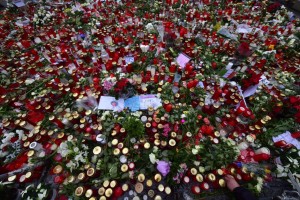The so-called Islamic State rushed to claim responsibility for last week’s Christmas market attack in Berlin, even with the alleged terrorist Anis Amri then on the run. (The 24-year-old Tunisian was killed a few days later in Milan.)
The jihadist group’s eagerness to cash in the propaganda chips is only one indication of how important it was and remains for ISIL to score a hit against Germany — especially after a string of aborted or limited attacks. Germany stands at the very core of ISIL’s strategy for Europe. It’s important to understand why in order to to think more clearly about possible remedies.
Dual goals
ISIL’s terror campaign in Europe began on May 24, 2014 when Mehdi Nemmouche attacked the Jewish Museum in Brussels, killing four people. This attack took place more than a year after the declaration of the Islamic State in Iraq and the Levant in the Syrian city of Raqqa, and a month before Abu Bakr al-Baghdadi, ISIL leader, proclaimed himself “caliph.” Even more important, Brussels occurred long before a U.S.-led coalition started bombing ISIL positions in Iraq, in August 2014, then in Syria the following month.
This timing is worth dwelling on for a couple reasons. For as much as ISIL says its terrorism is “retaliation” for Western air strikes against them, and as much as too many people take that claim at face value, repeating it only plays into the hands of jihadist propaganda. Note that Brussels was hit by terrorists last March, leaving 32 dead, at a time when Belgium wasn’t in any way active in the anti-ISIL coalition. It also misses the key to the dynamics of the ongoing terror campaign in Europe: There are bigger reasons why ISIL focuses on Europe that go beyond the lazy explanation of bombings and truck attacks (before Berlin came Nice in July) as a response to Western strikes in Syria and Iraq.
For ISIL, Europe is both a coveted pool of potential recruits and a dangerous counter-model of enduring coexistence. Terror attacks in Europe are intended to generate internal strife and societal tension in the hope of encouraging more young Muslim men (and more than a few women) to join the jihadist cause in Syria and Iraq. And, as importantly, to demonstrate and precipitate the failure of the democratic, European alternative to the jihadist caliphate.
The two main targets for ISIL are France and Germany. France because it is home to the Continent’s largest Jewish and Muslim populations that, while imperfect, shows how communities can live side by side. And Germany because of its generous open door to refugees from Syria and Iraq: ISIL propaganda is rabidly anti-refugee, accusing migrants of betraying the “true path” of the caliphate.
German jihadis
While last year’s Paris attacks highlighted roots ISIL has put down in France, the terror group has also tried to make inroads in Germany. At least 800 people have joined ISIL from Germany. Some reached prominent positions, like Reda Seyam, who was appointed “minister of education” before being killed in Iraq in December 2014. The leader of the German (and German-speaking) recruits is believed to be Mohammed Mahmoud, an Austrian-born “veteran” of jihadi propaganda, who had previously served al Qaeda media campaigns. Some 140 German-originated jihadis have been reported killed in Syria and Iraq, including at least 14 in suicide attacks.
On November 8, a major police operation in the German city of Hildesheim led to the arrest of the radical preacher nicknamed Abou Walaa. He is accused of organizing the recruitment and transfer of activists to ISIL. German security has now stated that he was in contact with Amri, the Berlin Christmas market attacker. Another police dragnet was launched one week after the Hildensheim operation against a similar network in Germany. Jihadi “veterans,” now back home, have started to be tried and condemned in German courts (as happened to three in Düsseldorf two months ago).
In France and Belgium, ISIL has used jihadi returnees from Syria and Iraq in terrorist attacks. In Germany, the group repeatedly used refugees instead of veterans to carry them out — without much success. It made sense to try since ISIL’s strategy in Germany is to undermine Angela Merkel’s liberal refugee policy through terror. A possibly serious attack by three jihadis posing as refugees on the old city of Düsseldorf was foiled after the surrender and confession of a Syrian militant in France, in February 2016; two asylum-seekers, one 17-year-old Afghan on a train in Würzburg and one 27-year-old Syrian at a music festival in Anbasch, died in suicide-attacks (that fortunately killed nobody else) under instructions from ISIL in Syria.
Western intelligence have warned about the activity of the Emni, or ISIL “security branch,” now in charge of “external operations” (meaning terror attacks abroad). The Bremen-born Harry Sarfo joined ISIL in April 2015 and was quickly recruited by the Emni, which sent him back home after only three months in the field. That decision and, following his capture, Sarfo’s testimony in court provided vivid proof of growing frustration inside ISIL over its inability to strike Germany. Despite its focus on the country, ISIL had failed to carry out any attack as deadly as in neighboring France.
politico.eu



